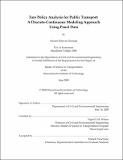| dc.contributor.advisor | Nigel H.M. Wilson. | en_US |
| dc.contributor.author | Zureiqat, Hazem Marwan | en_US |
| dc.contributor.other | Massachusetts Institute of Technology. Dept. of Civil and Environmental Engineering. | en_US |
| dc.date.accessioned | 2008-12-11T16:57:17Z | |
| dc.date.available | 2008-12-11T16:57:17Z | |
| dc.date.copyright | 2008 | en_US |
| dc.date.issued | 2008 | en_US |
| dc.identifier.uri | http://hdl.handle.net/1721.1/43748 | |
| dc.description | Thesis (S.M.)--Massachusetts Institute of Technology, Dept. of Civil and Environmental Engineering, 2008. | en_US |
| dc.description | This electronic version was submitted by the student author. The certified thesis is available in the Institute Archives and Special Collections. | en_US |
| dc.description | Includes bibliographical references (p. 115-117). | en_US |
| dc.description.abstract | In many large metropolitan areas, public transport is very heavily used, and ridership is approaching system capacity in the peak periods. This has caused a shift in attention by agency decision-makers to strategies that can more effectively manage the demand for public transport, rather than simply increase overall demand. In other words, a need has arisen to understand not only why people use public transport as opposed to other modes but also how they use public transport, in terms of their ticket, mode, and time-of-day choices. To that end, fares become an increasingly important policy tool that can trigger certain behavioral changes among riders. This thesis develops a methodology to model, at the disaggregate level, the response of public transport users to fare changes. A discrete-continuous framework is proposed in which ticket choice is modeled at the higher (discrete) level and frequencies of public transport use, based on mode and time-of-day, are modeled at the lower (continuous) level. This framework takes advantage of the availability of smartcard data over time, allowing individual-specific behavioral changes with various fare policies to be captured. This methodology is applied to London's public transport system using Oyster smartcard data collected between November 2005 and February 2008. The results indicate a strong inertia effect in terms of ticket choice among public transport users in London. An individual's prior ticket choice is found to be a very important factor in determining their future ticket choice. This is also evident when we simulate the effects of two policy changes on ticket choices. We find that the impact of changing the prices of period tickets may take several months or more to fully materialize. In terms of the frequency of public transport use, the results indicate estimated short and long-run fare elasticities of -0.40 and -0.64, respectively, for travel on the London Underground and equivalent estimates of -0.08 and -0.13 for travel on bus. | en_US |
| dc.description.abstract | (cont) The estimated Underground fare elasticities are comparable to those in the literature. The bus fare elasticities, on the other hand, are relatively smaller, in absolute value, than prior estimates. This difference reflects the small variations in bus fares in the dataset on which the model was estimated and the low fare sensitivity for users under such variations. Furthermore, we apply the model, in conjunction with related assumptions and findings from previous research, to evaluate an AM peak pricing scheme on the London Underground, in which travelers are charged £2.00 between 8:30am and 9:15am, rather than the current fare of £1.50. This application estimates that such a policy could potentially decrease AM "peak-of-the-peak" demand on the Underground by about 9%, with the reduction in ridership shifting either to a different mode or to a different time period. | en_US |
| dc.description.statementofresponsibility | by Hazem Marwan Zureiqat. | en_US |
| dc.format.extent | 117 p. | en_US |
| dc.language.iso | eng | en_US |
| dc.publisher | Massachusetts Institute of Technology | en_US |
| dc.rights | M.I.T. theses are protected by
copyright. They may be viewed from this source for any purpose, but
reproduction or distribution in any format is prohibited without written
permission. See provided URL for inquiries about permission. | en_US |
| dc.rights.uri | http://dspace.mit.edu/handle/1721.1/7582 | en_US |
| dc.subject | Civil and Environmental Engineering. | en_US |
| dc.title | Fare policy analysis for public transport : a discrete-continuous modeling approach using panel data | en_US |
| dc.type | Thesis | en_US |
| dc.description.degree | S.M. | en_US |
| dc.contributor.department | Massachusetts Institute of Technology. Department of Civil and Environmental Engineering | |
| dc.identifier.oclc | 263935440 | en_US |
